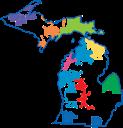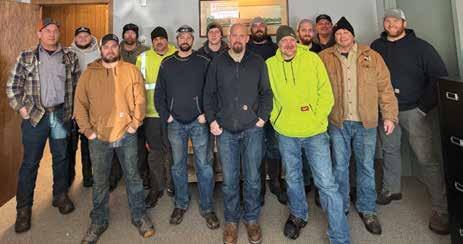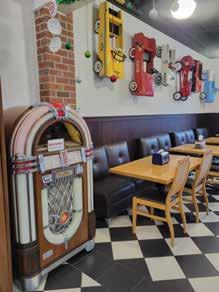MICHIGAN COUNTRY LINES

Be Prepared For Storm Outages
April 18 Is National Lineworker Appreciation Day


Be Prepared For Storm Outages
April 18 Is National Lineworker Appreciation Day

Think you can’t afford a geothermal heat pump?
After a closer look, you may be surprised at its overall affordability. Tax rebates can quickly bring down the initial costs of purchase and installation. And a geothermal heat pump is much cheaper to run than the most efficient furnaces and air conditioners. In fact, your energy bills can be cut by as much as 70%. As a result, many geothermal homeowners see a return on investment of 10-20% over the life of their system. When you crunch the numbers, you’ll see WaterFurnace is the money-saving choice. To learn more, contact your local WaterFurnace dealer today.
Geothermal is the only renewable that provides reliable operation 24 hours a day, 7 days a week, 365 days a year.
Allendale
Allendale Htg & Clg (800) 327-1937 allendaleheating.com
Berrien Springs WaterFurnace Michiana (269) 473-5667 gogreenmichgeo thermal.com
Big Rapids Stratz Htg & Clg, Inc. (231) 796-3717 stratzgeocomfort.com
Filion/Bad Axe
Air-O-Dynamic Htg & Clg (989) 582-0137 aod-hvac.com
Grand Rapids
Bel Aire Htg & Clg
1-888-235-2473 belaire.com
Hart Adams Htg & Clg (231) 873-2665
Holland G.H.P. Systems Inc. (616) 396-5833 ghpsystems-inc.com
Indian River M&M Plmb & Htg (231) 238-7201 mm-plumbing.com
Lansing Candor Mechanical (517) 920-0890 candormechanical.com
Michigan Center Comfort 1/Air Serv of Southern Michigan (517) 764-1500 airserv.com/southernmichigan/
Mt Pleasant
Walton Htg & Clg (989) 772-4822 waltonheating.com

Portage
Bel Aire Htg & Clg
1-888-235-2473 belaire.com
Portland ESI Htg & Clg (517) 647-6906 esiheating.com
Sunfield
Mark Woodman Plmb & Htg (517) 886-1138 mwphonline.com
Three Rivers
Bel Aire Htg & Clg
1-888-235-2473 belaire.com
Traverse City
Geofurnace Htg & Clg (231) 943-1000 geofurnace.com

Alger
Electric: up to $2,000
C h erryland Electric: up to $2,500
Cloverland: up to $6,275
Great Lakes Energy: up to $5,000
H omeworks/Tri-County Electric: up to $4,750
Presque Isle Electric & G as Co-op: up to $4,750
Thumb Electric: up to $2,000


EXECUTIVE EDITOR: Casey Clark
EDITOR: Christine Dorr
GRAPHIC DESIGNER: Karreen Bird
RECIPE EDITOR: Christin Russman
COPY EDITOR: Yvette Pecha
CONTRIBUTING EDITOR: Emily Haines Lloyd
PUBLISHER: Michigan Electric Cooperative Association
Michigan Country Lines, USPS591-710, is published monthly, except August and December, with periodicals postage paid at Lansing, Mich., and additional offices. It is the official publication of the Michigan Electric Cooperative Association, 201 Townsend St., Suite 900, Lansing, MI 48933.
Subscriptions are authorized for members of Alger Delta, Cherryland, Great Lakes, HomeWorks Tri-County, Midwest Energy & Communications, Ontonagon, Presque Isle, and Thumb electric cooperatives by their boards of directors.
POSTMASTER:
Send all UAA to CFS.
ASSOCIATION OFFICERS:
Chris O’Neill, HomeWorks TriCounty Cooperative, chairman; Gabe Schneider, Cherryland Electric Cooperative, vice chairman; Shaun Lamp, Great Lakes Energy Cooperative, secretary-treasurer; Craig Borr, president and CEO.
CONTACT US/LETTERS TO EDITOR: Michigan Country Lines 201 Townsend St., Suite 900 Lansing, MI 48933 248-534-7358 editor@countrylines.com
CHANGE OF ADDRESS: Please notify your electric cooperative. See page 4 for contact information.
The appearance of advertising does not constitute an endorsement of the products or services advertised.
MICHIGAN’S ELECTRIC COOPERATIVES




RECIPE CONTEST
See details on page 10. Summer Desserts, due April 1; Sandwiches & Wraps, due May 1. Win a $100 bill credit!
GUEST COLUMN
See details on page 18. Share your fondest memories and stories. Win $200 for stories published!
MYSTERY PHOTO
See details on page 18. Win a $100 bill credit!
To enter contests, submit reader content & more, visit countrylines.com/community
6 CRAIG BORR: A LEGACY OF LEADERSHIP & SERVICE
Borr’s unwavering advocacy for co-op members made MECA what it is today.
10 MI CO-OP KITCHEN
Best No Bake Recipes: Delicious desserts in no time.
14 BLOOM WHERE YOU’RE PLANTED: THE JOURNEY OF KALIN SHEICK
Sheick’s “why not” philosophy took her from TV journalism to founding a successful floral shop.
18 GUEST COLUMN
Farmyard Memories: A Great Lakes Energy member reflects on life with his father and their chickens.

500 J.K. Paul Street Ontonagon, MI 49953
906-884-4151
800-562-7128
After hours: 866-639-6098
OFFICERS & DIRECTORS
William Hodges, President Lake Linden District
906-934-3743 • district7@ontorea.com
Calvin Koski, Vice President Aura District 906-524-6988 • district4@ontorea.com
Mildred Ann Gasperich, Secretary Boston District 906-337-5079 • district6@ontorea.com
Randy Myhren, Treasurer Green/Firesteel/Toivola District 906-884-4092 • district1@ontorea.com
Jack Lehto, Director Pelkie/Herman/Aura District 906-353-6684 • district3@ontorea.com
Paul Koski, Director Ewen/Trout Creek/Lake Mine District district2@ontorea.com
Michael Gaunt, Director Chassell/Keweenaw Bay District 906-370-8133 • district5@ontorea.com
PERSONNEL
Dallas Aho, CEO/General Manager Alex Watson, Billing Clerk Justin Sironen, Operations Manager Kelsey Preiss, Administrative Assistant
OTHER INFORMATION
Date of Incorporation: Sept. 30, 1937 Fiscal year-end: Dec. 31 countrylines.com/coops/ontonagon
Ontonagon County REA is an equal opportunity provider and employer.
By Dallas Aho, General Manager

National studies consistently rank power line installers and repairers among the most dangerous jobs in the country, and for good reason. Laboring high in the air, wearing heavy equipment, and working directly with high voltage creates the perfect storm of a dangerous and unforgiving profession. But electric lineworkers are up to the task. These brave men and women are committed to safety and the challenges of the job.
Ontonagon REA’s lineworkers are responsible for keeping power flowing day and night, regardless of national holidays, vacations, birthdays, weddings, or other important family milestones. Beyond the years of specialized training and apprenticeships, it takes internal fortitude and a mission-oriented outlook to be a good lineworker. In fact, this service-oriented mentality is a hallmark characteristic of lineworkers. The job requires lineworkers to set aside their personal priorities to better serve their local community.
To perform their jobs successfully, lineworkers depend on their years of training, experience, and each other to get the job done safely. Equally important is their reliance on a strong support system at home. A lineworker’s family understands and supports their loved one’s commitment to the greater community during severe storms and power outages.
This means that during prolonged outages, the family and their lineworker may communicate minimally and not see each other for several days. Without strong family support and understanding, this challenging job would be all the more difficult.
In the Upper Peninsula and across the country, electric co-op lineworkers’ missionfocused mentality of helping others often extends beyond their commitment to their work at the co-op. Lineworkers are often familiar figures in the community. They can be found coaching youth sports teams, volunteering for local charities, and serving as members of the local fire departments and/or advisory boards.
April 18 is Lineworker Appreciation Day. Given the dedication of Ontonagon REA’s lineworkers, both on and off the job, I encourage you to take a moment to acknowledge their many contributions to our local community. And if you see their family members in the grocery store or out and about in the town, please offer them a thank-you as well.
Ontonagon REA recently welcomed Brandon Scroggs as their newest lineman. Brandon was born in Texas, but at age 8, his family moved to Baraga County to be closer to family. He grew up in Skanee and graduated from L’Anse High School. After several years of college, he found himself at a crossroads regarding exactly what he wanted to do. “I’ve always loved the outdoors and climbing anything high, so that led me to apply to the Electrical Line Technician Program at NMU,” he says.
After graduating from the program, he furthered his training at the Missouri Valley Line Constructors
America’s electric cooperatives have designated April 18 as National Lineworker Appreciation Day. At Ontonagon REA, members of our Distribution Department are the “first responders“ of our electric system. On April 18, we make a special point of honoring them for the services they perform, around the clock and in dangerous conditions, to keep power flowing and protect the public’s safety. When an outage call comes in, they leave their families, whether it’s dinnertime, a weekend, or a holiday, to find and fix the problem. They work hard to keep the power flowing through
Apprenticeship Program. His work for various contractors involved considerable travel throughout the Midwest, with jobs in Iowa, Minnesota, and Wisconsin. Looking for something that would provide more of a solid home base, he applied to Ontonagon REA and began working for them in July 2024. “When the opening came up, I jumped on it. I know this area and the people well,” he said. “It’s home.”
Brandon lives in Baraga with his wife, Christine, and 1-year-old daughter, Piper. In his spare time, he enjoys hunting, fishing, mountain biking, and hiking.
General Manager Dallas Aho is pleased to have Brandon on board.

“Brandon brings considerable experience with him and is already familiar with our service territory. He is a great fit for the Ontonagon REA team,” he said.

our communities and are the backbone of every power system.
Ontonagon REA would like to recognize members of the Distribution Department and thank them for their dedication and service.
Members of the department are as follows (from left to right): Nels Erickson, Dallas Aho (CEO), Adam Hawkins, Matt Urbis (tree crew), Scott Anderson (tree crew), Kaleb Preiss, Brady Erickson, Kelly Clark, Dave Brown, John Myllylahti (tree crew), Justin Sironen, Luke Jouppe, Gil Martinez, Brandon Scroggs
In accordance with Federal civil rights law and U.S. Department of Agriculture (USDA) civil rights regulations and policies, the USDA, its Agencies, offices, and employees, and institutions participating in or administering USDA programs are prohibited from discriminating based on race, color, national origin, religion, sex, gender identity (including gender expression), sexual orientation, disability, age, marital status, family/parental status, income derived from a public assistance program, political beliefs, or reprisal or retaliation for prior civil rights activity, in any program or activity conducted or funded by USDA (not all bases apply to all programs). Remedies and complaint filing deadlines vary by program or incident. Persons with disabilities who require alternative means of communication for program information (e.g., Braille, large print, audiotape, American Sign Language, etc.) should contact the responsible Agency or USDA’s TARGET Center at (202) 720-2600 (voice and TTY) or contact USDA through the Federal Relay Service at (800) 877-8339. Additionally, program information may be made available in languages other than English. To file a program discrimination complaint, complete the USDA Program Discrimination Complaint Form, AD-3027, found online at http://www.ascr.usda.gov/complaint_filing_cust.html and at any USDA office, or write a letter addressed to USDA and provide in the letter all of the information requested in the form. To request a copy of the complaint form, call (866) 632-9992. Submit your completed form or letter to USDA by:
1. mail: U.S. Department of Agriculture Office of the Assistant Secretary for Civil Rights, 1400 Independence Ave., SW, Washington, D.C. 20250-9410; 2. fax: (202) 690-7442; or 3. email: program.intake@usda.gov. This institution is an equal opportunity provider.

By Emily Haines Lloyd
In the heart of the electric cooperative industry, where service to members and communities is key, individuals like Craig Borr tend to stand out. With nearly 40 years of dedicated service, including 13 years as President and CEO of the Michigan Electric Cooperative Association (MECA), Borr has been a tireless advocate for Michigan’s electric cooperatives. So, it’s no small thing when a leader like Borr retires, and it’s defi nitely worth taking a moment to reflect on all he’s done to support our members in rural Michigan.
Craig’s journey began fresh out of college when he joined Wolverine Power Cooperative. Starting in communications, his passion for the cooperative movement quickly set him apart. Over the years, his focus on deeply understanding member needs and fostering connections propelled him to leadership roles, ultimately serving as Wolverine’s Executive Vice President and taking the helm at MECA in 2012.
“For over a decade and during times of tremendous transition in Michigan, we are deeply grateful for Craig’s sound leadership, strategic vision, and steady hand,” said MECA Board Chairman Chris O’Neill.
Throughout his career, Borr has been a critical voice for rural Michiganders, championing legislative efforts in both Lansing and Washington, D.C. His hard work has led to historic wins, including securing broadband funding, favorable provisions in Michigan’s Clean Energy packages and, most recently, bipartisan legislative support for a New ERA grant application
“The man never stops,” said Dawn Coon, Wolverine’s VP of Administration. “He has an uncanny ability to absorb information and turn it into action.”
Craig’s advocacy also extended to national issues, such as his instrumental role in passing the Cooperative and Small Employer Charity Pension Flexibility Act of 2014, which saved billions in pension costs.
Under Craig’s leadership, MECA fostered a spirit of collaboration among Michigan’s electric cooperatives, culminating in a longterm membership agreement and updated dues structure. His innovative vision also led to the establishment of Wolverine Power Marketing Cooperative (WPMC), the nation’s fi rst retail choice cooperative serving large commercial and industrial members. As the founder and fi rst CEO of WPMC, he spearheaded the creation of a $100M organization that delivers the benefi ts of electric choice within a cooperative environment to several of Michigan’s leading corporations and universities.
“Craig gets excited about the art of the possible,” said Casey Clark, MECA Director of Communications and Marketing. “His energy and ideas have driven Wolverine and MECA to new heights.”
As Craig prepares to usher in a new era of leadership and growth for MECA, his legacy of innovation, advocacy, and unwavering service leaves a strong foundation for future growth.
“Craig has been a trusted business partner for nearly 40 years,” said Eric Baker, President & CEO of Wolverine Power Cooperative. “He is a relentless networker, a creative problem solver, and a proud advocate for the cooperative mission. His impact on our cooperatives and members is immeasurable and his contributions will resonate for decades.”
By Craig Borr
Michigan’s electric cooperatives have come a very long way since their inception in rural Michigan more than 80 years ago. For the past 40 years, I have been fortunate to have served in a number of electric cooperative leadership roles—the last 13 as President/CEO of the Michigan Electric Cooperative Association. In March, I will be retiring from that role.
I am proud to have served with so many great employees and directors over the years and have met thousands of electric cooperative members from Chassell to Posen and from Bad Axe to Cassopolis. They share one common trait—they are good people who are committed to improving the quality of life for our member-consumers who live in rural Michigan.
A few observations as I head towards retirement:
1. Be thankful that you are a member of a Michigan electric cooperative. They care about the communities they serve and are governed by a board of community leaders that you elect to represent your interests. It is the democratic process in action—and it still works.
2. Michigan’s electric cooperatives are leaders in competitiveness, reliability, and carbon-free electricity. The Michigan Public Service Commission sets a series of reliability metrics each year—and each year, electric cooperatives typically exceed those standards set by state regulators.


3. In a year or so, nearly all of the electricity sold by Michigan’s electric cooperatives is set to be “carbon free.” State law calls for Michigan utilities to be “carbon free” by 2040. We are leaders in that metric also and will be 15 years ahead of the state mandate! We were also a part of the state’s fi rst commercial wind farm in 2006 and the state’s fi rst community solar project in 2012. That’s leadership on reducing our carbon footprint—and doing so smartly and competitively!
Rural Michigan is “better” because of Michigan’s electric cooperatives. They brought electricity to rural areas when the large, for-profi t electric utilities in our state would not serve those areas. Many of Michigan’s electric cooperatives are now also bringing high-speed fi ber internet to many of those same rural and remote areas—again because the large telecommunications companies would not serve those areas.
Further, many rural Michigan consumers can now access high-speed fiber internet for monthly prices that are less than those in many urban areas of the United States. Michigan co-ops also do it with no data caps or contracts!
4. Electric cooperatives are signifi cant economic drivers in the local economies where they serve. They are signifi cant employers in Michigan and sizable property taxpayers in the communities they serve. In addition, they are leaders in local economic development initiatives in rural Michigan.
While I am proud of my simple contributions over the past four decades, I am prouder of the job that Michigan’s electric cooperatives do every day in rural Michigan. They lead in many rural and sparsely populated areas where no others are often willing to lead. Be thankful that you are a member of an electric cooperative. Your life is better as a result of their work and by being a member—not a customer.
“Rural Michigan is ‘better’ because of Michigan’s electric cooperatives.”

Our region can produce some extreme weather conditions, regardless of the season. Be prepared with these tips.
• Water: At least one gallon per person, per day, plus some for pets
• Food: Nonperishable, especially items that don’t require cooking, along with a hand-operated can opener
• Lighting: Flashlights, candles, and matches
• Telephone: Cordless phones won’t work during an outage, so have a corded phone available. Make sure cell phones are fully charged if outages are possible
• Communications: Have your mobile devices fully charged if outages are imminent so you can stay in the know. A battery-powered radio is also helpful
• Medical: First-aid kit ready with any needed medical supplies and filled prescriptions
• Personal sanitation: Moist wipes, hand sanitizer, and garbage bags
• Tools: Wrench or pliers to turn off utilities
• Batteries
• Battery-powered or wind-up clock
• Extra blankets
• Stay away from downed power lines and warn others to do the same. Call us immediately to report downed power lines
• Don’t touch a person or object in contact with a power line; the electric current could flow through you
• Stay inside your car if it comes in contact with a power line
• Turn off all appliances during an outage to avoid a circuit overload when power is restored. Leave on one lamp to know when power is restored
• Never leave burning candles unattended
• Keep freezer and refrigerator doors closed. Food will stay frozen for 36 to 48 hours in a fully loaded freezer and about 24 hours in a partially filled freezer
When you’re in the dark and trying to report your power outage, there’s nothing more frustrating than sitting in a crowded phone queue waiting for the next available rep. We offer easy and convenient ways to report your outage.
SmartHub: SmartHub, our secure online portal and mobile app, is the quickest and easiest way to report your outage. Sign up for SmartHub at ontorea.smarthub.coop or download the app from your app store.
Telephone: Dial 906-884-4151 and after hours 866-639-6098 and follow the prompts. We must have a current telephone number for your account. Please update your account information using SmartHub or by calling our office.
We have limited incoming telephone lines. If you call and receive a fast busy signal, please use one of the alternate methods, or hang up and try again.
Please do not use email or social media to report your outage; these platforms are not staffed 24/7.










1. Pretty with pink. Sherry Trepanier
2. The Keweenaw Waterway Lower Entrance Light rises above the bay with the Kaye E. Barker in the background. Nathan Miller
3. Beautiful evening at Rice Lake. Linda Stubenrauch
4. A beautiful winter sunrise!! Johanna Simula
5. Can’t beat the sunsets on Rice Lake. Deb Maki
6. Sunset storm over Lake Superior. Al Powers
7. Sunrise on Golden Glow Rd. Lisa Rhodes
8. Sunset in Misery Bay, Michigan. Robin Mueller
9. Sunrise at the Verna Mize, an annual triathlon in Houghton. Mary Kaminski
10. Sunrise walk in Marquette. Ayla Miller
Enter to win a $50 energy bill credit!
Submit A Photo & Win A Bill Credit! Ontonagon REA members whose photos we print in Michigan Country Lines during 2025 will be entered in a drawing. Four lucky members will win a credit of $50 on their December 2025 energy bills!
Upcoming Topics and Deadlines: Michigan’s Farmlands, due March 25 (May/June issue) Michigan’s Waterfalls, due May 25 (July/Aug. issue)
To submit photos, and for details and instructions, go to http://bit.ly/countrylines We look forward to seeing your best photos!

Deb Mitteer, Great Lakes Energy
½ stick butter (melted)
1½ cups graham cracker crumbs
8 ounces cream cheese (softened)
1 can sweetened condensed milk
¾ cup lime juice
8 ounces whipped topping
In cupcake pans, line 18 cups with paper cupcake liners. Mix melted butter with graham cracker crumbs. Divide evenly into cupcake liners. Pat down fi rmly. In a mixing bowl, add cream cheese and blend with mixer until smooth. Add sweetened condensed milk and lime juice, and mix until smooth. Fold in whipped topping. Divide evenly into the cupcake liners. Place in freezer and serve frozen.




Marie Mercier, Great Lakes Energy
4 cups Cheerios
2 cups Rice Krispies
2 cups dry roasted peanuts (I use unsalted)
2 cups M&Ms
1 cup light corn syrup
1 cup sugar
1½ cups creamy peanut butter
In a large bowl, combine Cheerios, Rice Krispies, peanuts, and M&Ms. Set aside. In a saucepan, bring corn syrup and sugar to a boil, stirring frequently. Remove from heat. Stir in peanut butter. Pour over cereal mixture and toss to coat evenly. Spread into a greased 10x15x1-inch baking pan. Cool. Cut into bars.
Deb Finedell, Great Lakes Energy
18 graham crackers, crushed
½ cup butter, melted
1 (20-ounce) can crushed pineapple
1 (21-ounce) can strawberry pie filling
4 cups mini marshmallows
1 (16-ounce) container whipped topping, thawed
2 cups frozen strawberries, partially thawed, chopped
Mix the graham cracker crumbs and butter until it has the consistency of wet sand. Spoon the crumb mixture into the bottom of a 9×13-inch baking dish; press the crumbs into an even layer. Chill the crust in the fridge for at least 15 minutes. Strain the excess juice from the pineapple and mix with pie fi lling. Add the marshmallows and stir until they are completely coated in the fruit. Spoon the whipped topping into the bowl and gently fold it into the fruit mixture until combined and it becomes pink in color. Fold in the partially thawed strawberries. Scoop the whipped topping and fruit mixture onto the chilled crust, gently smoothing it out until even. Cover the pan tightly and chill in the fridge for at least 4 hours.
Rhonda Carlson, HomeWorks Tri-County Electric
1 stick margarine or butter
½ cup milk
1½ cups sugar
1 cup peanut butter
2 cups quick oats
Bring butter, milk, and sugar to a rolling boil for 3 minutes. Remove from heat. Add peanut butter and oats, and mix until well blended. Drop by spoonfuls on wax paper. Let cool, then enjoy.
the increasing need for power affects electric co-ops and their members
By Scott Flood
When rural electric cooperatives first strung power lines from farm to farm, across arroyos, and through remote forests less than a century ago, most members had but a handful of light bulbs to power. With time, they added appliances like refrigerators, but we’re sure they couldn’t begin to imagine the number and variety of electrical devices in today’s homes and garages.
Across the U.S., people use a growing amount of electricity at work, at home and, with the growth of electric vehicles (EVs), even on the road.
The demand for electricity increased by 2.5% in 2024 and is expected to grow by 3.2% this year. That was after co-ops saw a 4.8% increase in 2022. Through 2029, the nation’s peak demand is projected to grow by 38 gigawatts. That would be like adding another California-sized state to our nation’s power grid.
The rapid growth of artificial intelligence (AI) is driving the development of massive data center facilities, often placed in electric co-op service territories to take advantage of inexpensive land and fewer neighbors to complain. By 2022, these facilities accounted for 2.5% of the nation’s consumption of electricity—and by 2030, they’ll use 7.5% of all electric power.
Data centers and facilities like warehouses require a large, steady supply of electricity 24 hours a day. That means the electric co-ops supplying them can’t rely on intermittent sources of electricity such as solar or wind energy to handle the additional load. Instead, they need more of what’s known as baseload or always-available power, much of which is currently generated by burning fossil fuels. The more we depend on technology, the more we’ll need reliable baseload generation.
In Michigan, the challenge is further complicated by the state’s ambitious goal of achieving 100% carbon-free energy by 2040. Fortunately, Wolverine Power Cooperative, Ontonagon REA’s power partner, is well-equipped to help tackle this challenge. Wolverine has secured an agreement to source reliable, carbon-free baseload power from the Palisades Power Plant once it restarts. This innovative solution will provide the state with a consistent, competitively priced source of baseload generation for decades, supporting grid stability as electricity demand continues to rise. However, both Wolverine and Ontonagon REA members are not immune to the broader challenges, as we share the grid and its power supply with other utilities.
The U.S. Energy Information Administration’s forecast expects coal-fired generation to drop to half of today’s levels by 2030. Renewable energy will capture a growing share of the supply, but as noted, much of renewable energy is not reliable enough to provide baseload power.
As electricity powers a growing share of life’s tools and conveniences, overall demand is expected to continue its steady growth through 2050. A great example is the efficiency of electric heat pumps. Federal and other subsidies and tax advantages are powering significant growth in their share of the home heating market.
In other words, at the same time everyone is using more electricity than ever, the supply of the most reliable source is drying up. Add in the uncertainty created by public policy debates around energy and climate change, and you can begin to understand why 19 states face a high risk of rolling blackouts between now and 2028.

“As electricity powers a growing share of life’s tools and conveniences, overall demand is expected to continue its steady growth through 2050.”
The energy industry studies demand closely because construction of all types of generation is costly and lengthy—often longer than a decade from groundbreaking to entering service.
As renewables become more efficient and cheaper to produce, their share of the power mix will only continue to grow. Someday soon, battery technology may reach the point where large-scale storage of renewable generation becomes possible, but until then, we’ll need more of those alwaysavailable power sources.
One more factor plays a key role in the ability of co-ops and the rest of the nation’s power industry to keep up with demand. That’s the supply chain, in which many U.S. suppliers simply can’t keep up with the nation’s needs for power equipment. When a co-op orders new transformers, it may have to wait two years or more for delivery and pay a significantly higher price.
Expect to hear more about the challenges created by record demand for electricity in the coming years.
A er decades of flat or declining electricity demand, the United States is in the midst of a boom in power use. Recent government data shows that power consumption nationwide is set to increase by at least 38 gigawatts between now and 2028. This trend would ordinarily be great news for the power industry. But government policies aimed at shutting down fossil-fuel-based generation and years-long delays in permitting and siting for new transmission lines are turning this power boon into a capacity crisis. Here are the primary demand drivers:
Electric vehicle adoption, electrification of home heating, and industrial electrification are expected to increase overall U.S. energy consumption by 1% per year through 2026.
Driven by explosions in artificial intelligence, cryptocurrency, and cloud computing, total U.S. data center load is projected to increase by 65% by 2050.
Residential power consumption is expected to increase by 14% to 22% through 2050 due to increases in population and steady economic growth.
New, expanding, and “onshored/reshored” manufacturing capacity driven by federal incentives is expected to increase industrial demand by 13,000 GWh per year.
Analysts predicted in 2023 that U.S. peak demand will increase by at least 38 GW over the next five years, nearly double the growth rate predicted in 2022.

“Embrace your weird thing. It’s what makes you stand out from the rest.”
Kalin Sheick’s journey from TV journalist to the founder of Sweetwater Floral is rooted in what she calls “delusional confi dence”— a spark of self-belief that dares to ask, “Why not me?”
WHERE YOU’RE PLANTED
By Emily Haines Lloyd
This mindset, characterized by a fearless willingness to pursue unconventional dreams, propelled Sheick to build a fl ourishing business and inspire others to embrace life’s possibilities. Her philosophy, BLOOM— “building life out of moments”— encapsulates her belief that beauty and meaning can be created in the everyday.
Why Not Bring Joy to the World?
In 2014, Sheick, a Great Lakes Energy cooperative member, found herself at a crossroads. Newly married and questioning her future in TV journalism, she began to feel the
pull toward something different. She loved northern Michigan and wanted to stay rooted there, but her career in journalism didn’t align with her vision of a balanced, present life. Inspired by the small business owners she had covered as a reporter, Sheick asked herself: “Why not me? Why not build something here?”
“I had this gut feeling that I was playing safe and small,” said Sheick. “But at some point, you have to put all of yourself out there and you can’t be scared of what people will think.”
By 2015, she had turned her curiosity about entrepreneurship and her creativity with self-taught floral design into Sweetwater Floral. The village of Walloon Lake, where she had gotten married, became a symbolic cornerstone of her journey. Her confidence drove her to carve out
her unique space, offering designs for weddings and events, as well as hosting floral workshops that have garnered national interest.
Why Not Something More?
Sheick’s philosophy goes beyond arranging fl owers; it’s about creating moments that matter. She wants her customers and workshop participants to feel inspired and capable, free from the pressure of perfection.
This message resonated on a larger scale when Sheick gave a TED Talk in 2019, framing fl owers as a life hack for joy and connection. The experience solidifi ed her belief that Sweetwater Floral helps people tap into their own uniqueness.
“Embrace your weird thing,” said Sheick. “It’s what makes you stand out from the rest.”
Why Not Dream Big?
Kalin’s “delusional confi dence” continues to push her to explore new ventures. She and her husband Matt launched the podcast “Lucky Girls Don’t Quit” to share the behind-thescenes journey of running Sweetwater Floral while raising a family.

“Why not a podcast?” she thought. “We love the idea of sharing our lives— as a refl ection of this exact moment in time and hoping it reached people who can relate.”
Looking to the future, Kalin can picture a return to television. Flowers are inherently visual, and she dreams of showcasing the beauty of northern Michigan alongside the heartfelt stories that inspire her work.

“Why not TV again?” she asks. “Why not share this beauty with the world?”
Why Not Begin to BLOOM?
Kalin Sheick’s story is a powerful reminder that sometimes the key to success is simply daring to believe in yourself. Her “delusional confi dence” has transformed Sweetwater Floral from a small-town business into a lifestyle brand that inspires people to build lives rich with beauty and connection. Through her BLOOM philosophy, Kalin continues to spark joy and remind us all to embrace the question: “Why not me?”
Sweetwater Floral 4128 N. M-75, Walloon Lake, Michigan 49796
LISTEN TO THE PODCAST “Lucky Girls Don’t Quit” is available on Spotify and Apple Podcasts.
Not only a haven for auto enthusiasts, Gilmore Car Museum offers a glimpse into the past. It’s an immersive experience and voyage through American automotive culture. It’s also a place where history, artistry, and nostalgia come together in a remarkable setting, tucked away in the countryside of Hickory Corners, Michigan. Spanning over 90 landscaped acres, Gilmore Car Museum encompasses nearly 200,000 square feet of exhibit space, a sprawling historic campus housing over 400 vehicles, a dozen buildings, and several life-size reenactments.
The museum started as a hobby in the 1960s for its founder, Kalamazoo businessman Donald S. Gilmore. Today, it is a living testament to the innovation and evolution of the automotive industry, welcoming more than 112,000 visitors annually and drawing guests from all over the world. Gilmore Car Museum is considered the largest auto museum in North America.

Donald S. Gilmore journeyed into the world of collecting vintage cars in 1963 with the purchase of a 1920 Pierce-Arrow. This ignited his passion for classic cars and paved the way for Gilmore Car Museum to be the significant landmark it is today. Gilmore bought an abandoned 19th-century farm property to hold his ever-growing car collection. He refurbished eight historic barns to create a blend of rustic charm that paired with the twinkle of polished chrome. With 35 cars on display, the Gilmore Car Museum opened its doors on July 31, 1966, as a nonprofit educational institution dedicated to preserving the heritage of automobiles in America.
Gilmore Car Museum showcases a stunning lineup of historic machines and specialty exhibits, from horseless carriages to sleek modern roadsters. Motorcycles, bicycles, hood ornaments, and other symbolic artifacts all trace the progression of automobile design and engineering. Vehicles from all eras are on display, from luxurious Duesenbergs to iconic DeLoreans. The museum’s oldest exhibit is an 1899 Locomobile Steam Car. Classic car enthusiasts appreciate early 20th-century models from brands like Cadillac, PierceArrow, and Packard, while fans of American muscle cars are thrilled by the Chevelles, Mustangs, and Corvettes. Sophisticated European names, like Aston Martin and RollsRoyce, represent global automakers.
One of the most fascinating aspects of Gilmore Car Museum is its commitment to recreating the atmosphere of automotive history. It offers inviting spaces immersed in decades gone by. Transport back in time at the museum’s restored 1890s

train depot. Dine in a different era at George & Sally’s Blue Moon Diner, an authentic and fully operational 1941 diner serving classic American fare. Imagine fueling up during the Great Depression at the 1930s Shell gas station, complete with original gas pumps and signage. Visit four unique auto dealerships (listed below), each designed to reflect a distinct period. Every detail has been meticulously crafted, from tiled floors to neon lights, to evoke the essence of car shopping in mid-century America.
• The 1918-era Franklin dealership
• The 1928 Model A Ford dealership
• The 1930 Lincoln dealership
• The 1948 Cadillac dealership
The Museum’s Checker Cab and London Double Decker bus can often be seen traveling along the paved roadways around campus.


Chauffeured vintage rides are free with your admission during summer and special events like Winter Wonderland.
Experience time travel and enjoy a thrilling three-mile ride behind the wheel of a 100-year-old Model T Ford. Secure your seat in a hands-on driving class for the opportunity to take a “Tin Lizzie” for a spin alongside an experienced instructor.
The Gilmore Car Museum is open yearround, though the outer buildings are closed during winter months. Refuel at two on-site restaurants: Pedal Car Cafe is open daily, and Blue Moon Diner is open from March through November.
The museum is a must-see pit stop in southwest Michigan, situated midway between Kalamazoo, Battle Creek, and Grand Rapids at 6865 Hickory Road, Hickory Corners, MI 49060
/GilmoreCarMuseum /gilmorecarmuseum @gilmorecarmuseum7323 gilmorecarmuseum.org
Scan the QR code to watch a video of our visit and vintage ride at Winter Wonderland.
Cassondra Scott is a content creator, writer, and social media influencer at Cassondra Wanders— sharing small businesses and sights to see all over the state of Michigan.


By Stanley Hagemeyer, a Great Lakes Energy cooperative member

MYSTERY PHOTO
Win a $100 energy bill credit!
Identify the correct location of the photo above by March 25 and be entered into a drawing to win a $100 electric bill credit. Enter your guess at countrylines.com/community

JANUARY 2025 WINNER!
Our Mystery Photo winner is Jerry Ullery, an Ontonagon REA cooperative member who correctly identified the photo as downtown Bellaire, Michigan.
Winners are announced in the following issues of Country Lines: January, March, May, July/August, September, and November/December.
When I was growing up, our family lived on a farm with four cows, about 20 pigs, and perhaps a hundred chickens. Until I was about 7, we had two old workhorses, too. By the time I was 12, my father had quit raising cows and pigs, but we had chickens that were housed in the big red barn.
The chickens were always free to wander around the yard to scavenge for food. Chickens were easy to care for and provided plenty of fresh eggs. Any extra eggs were taken into town to sell at the produce office. My father gave the chickens ground “layer” feed in the morning. In the afternoon, he always walked to the granary with a pail to get some oats for them. The chickens must have considered the oats a special treat. It was not long before those smart chickens learned that when Dad came to the barn to pick up the empty pail, he was going to get the oats. They would turn and follow him all the way to the granary like a row of eager pets.
When he came out with the full pail, he scattered the oats on the ground, and the chickens would gather all around to eat that treat. During 7th grade, I earned a camera at school by selling magazine subscriptions to all our relatives. One afternoon, I saw the chickens following Dad and snapped a picture of those smart chickens. Our terrier, Ginger, can be seen watching the parade, which occurred every day.
About the Author: Stanley is a retired Christian minister. He is the last of his generation of cousins and has written a historical novel describing the life of his Hagemeyer grandparents from their marriage in 1900 to their golden anniversary in 1950 (primarily for the enjoyment of their descendants).
GUEST COLUMN Win $200 for stories published! Share your fondest memories and stories. Win $200 for stories published. Visit countrylines.com/community to submit.



Attaches to your home’s existing heating system, it does not replace it.
Delivers 90% on average of your home’s heating needs and 100% of your home’s cooling needs.
If you have a well and are heating with propane, fuel oil, electric, or wood, your current heating and cooling cost is likely greater than it would be to fully finance and heat & cool with a Well-Connect.
Installs in one day, any time of year. No drilling required.


We thank electrical lineworkers for their commitment to powering our local communities. APRIL 18, 2025
